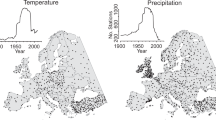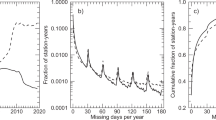Abstract
Risk assessment of natural hazards is often based on the actual or forecast weather situation. For estimating such climate-related risks, it is important to obtain weather data as frequently as possible. One commonly used climate interpolation routine is DAYMET, which in its current form is not able to update its database for periods of less than a year. In this paper, we report the construction of a new climate database with a standard interface and implement a framework for providing daily updated weather data for online daily weather interpolations across regions. We re-implement the interpolation routines from DAYMET to be compliant with the data handling in the new framework. We determine the optimal number of stations used in two possible interpolation routines, assess the error bounds using an independent validation dataset and compare the results with a previous validation study based on the original DAYMET implementation. Mean absolute errors are 1°C for maximum and minimum temperature, 28 mm for precipitation, 3.2 MJ/m² for solar radiation and 1 hPa for vapour pressure deficit, which is in the range of the original DAYMET routine. Finally, we provide an example application of the methodology and derive a fire danger index for a 1 km grid over Austria.







Similar content being viewed by others
References
Baier P, Pennerstorfer J, Schopf A (2007) PHENIPS—a comprehensive phenology model of Ips typographus (L.) (Col., Scolytinae) as a tool for hazard rating of bark beetle infestation. Forest Ecol Manag 249:171–186
Brooker P (1979) Kriging. Eng Min J 180:148–153
Burgan RE (1988) Revisions to the 1978 national fire-danger rating system. Research paper SE-273. U.S. Department of Agriculture, Forest Service, Southeastern Forest Experiment Station, Asheville, NC
Burgan RE, Andrews PL, Bradshaw LS, Chase CH, Hartford RA, Latham DJ (1997) WFAS: wildland fire assessment system. Fire Manag Notes 57:14–17
Carlson JD, Burgan RE (2003) Review of users’ needs in operational fire danger estimation: the Oklahoma example. Int J Rem Sens 24:1601–1620
Carrega P (1991) A meteorological index of forest fire hazard in mediterranean France. Int J Wildland Fire 1:79–86
Chang K-T, Chiang S-H (2008) An integrated model for predicting rainfall-induced landslides. Geomorphology 105:366–373
Changnon SA (2007) New risk assessment products for dealing with financial exposure to weather hazards. Nat Hazards 43:295–301
Cressie NA (1993) Statistics for spatial data, revised edition. Wiley, New York
Cruden DM (1991) A simple definition of a landslide. Bull Int As Eng Geol 43:27–29
Dai FC, Lee CF, Ngai YY (2002) Landslide risk assessment and management: an overview. Eng Geol 64:65–87
Eastaugh CS, Petritsch R, Hasenauer H (2010) Climate characteristics across the Austrian forest estate from 1960 to 2008. Austr J Forest Res 127:133–146
Ellis AW, Leathers DJ (1999) Analysis of cold airmass temperature modification across the US Great Plains as a consequence of snow depth and albedo. J Appl Meteorol 38:696–711
Hasenauer H, Merganičová K, Petritsch R, Pietsch SA, Thornton PE (2003) Validating daily climate interpolations over complex terrain in Austria. Agr Forest Meteorol 119:87–107
Hong Y, Adler RF, Negri A, Huffman GJ (2007) Flood and landslide applications of near real-time satellite rainfall products. Nat Hazards 43:285–294
Jones PG, Thornton PK (2000) MarkSim: software to generate daily weather data for Latin America and Africa. Agron J 92:445–453
Keetch JJ, Byram GM (1968) A drought index for forest fire control. Research paper SE-38. U.S. Department of Agriculture, Forest Service, Southeastern Forest Experiment Station, Asheville, NC
Meek DW (1997) Estimation of maximum possible daily global solar radiation. Agr Forest Meteorol 87:223–241
Nonhebel S (1994) The effects of use of average instead of daily weather data in crop growth simulation models. Agr Syst 44:377–396
Petritsch R (2002) Anwendung und Validierung des Klimainterpolationsmodells DAYMET in Österreich. Master thesis, University of Natural Resources and Applied Life Sciences, Vienna
Rawat V, Saraf AK, Das J, Sharma K, Shujat Y (2011) Anomalous land surface temperature and outgoing long-wave radiation observations prior to earthquakes in India and Romania. Nat Hazards, doi:10.1007/s11069-011-9736-5
Running SW, Coughlan JC (1988) A general model of forest ecosystem processes for regional applications. I. Hydrological balance, canopy gas exchange and primary production processes. Ecol Model 42:125–154
Schuster RL (1996) Socioeconomic significance of landslides. In: Turner AK, Schuster RL (eds) Landslides: investigation and mitigation, Special Report 247. Transportation Research Board, National Research Council. National Academy Press, Washington, pp 12–35
Semenov MA, Barrow EM (1997) Use of a stochastic weather generator in the development of climate change scenarios. Clim Change 35:397–414
Shepard D (1968) A two-dimensional interpolation function for irregularly-spaced data. In: Proceedings of the 1968 ACM national conference, pp 517–524
Soltani A, Latifi N, Nasiri M (2000) Evaluation of WGEN for generating long term weather data for crop simulations. Agr Forest Meteorol 102:1–12
Thornton PE, Running SW, White MA (1997) Generating surfaces of daily meteorological variables over large regions of complex terrain. J Hydrol 190:214–251
Thornton PE, Hasenauer H, White MA (2000) Simultanous estimation of daily solar radiation and humidity from observed temperature and precipitation: an application over complex terrain in Austria. Agr Forest Meteorol 104:255–271
Viegas DX, Bovio G, Ferreira A, Nosenzo A, Sol B (1999) Comparative study of various methods of fire danger evaluation in Southern Europe. Int J Wildland Fire 9:235–246
Wermelinger B, Seifert M (1998) Analysis of the temperature dependent development of the spruce bark beetle Ips typographus (L.) (Col., Scolytidae). J Appl Entomol 122:185–191
Acknowledgments
This research was partly funded by two projects from the Austrian Science Foundation (FWF): The ‘Austrian Forest Fire Research Initiative’ and ‘Application of ergodic theory within ecosystem modelling’. Thanks to the Central Institute for Meteorology and Geodynamics, for providing the daily climate records. We thank Peter E. Thornton for making the original version of DAYMET available, Herbert Formayer for data handling support and Chris Eastaugh for English language editing. We also thank Prof. Thomas Glade for organising the session on Natural Hazards during the EGU conference 2009 in Vienna and the anonymous reviewers.
Author information
Authors and Affiliations
Corresponding author
Rights and permissions
About this article
Cite this article
Petritsch, R., Hasenauer, H. Climate input parameters for real-time online risk assessment. Nat Hazards 70, 1749–1762 (2014). https://doi.org/10.1007/s11069-011-9880-y
Received:
Accepted:
Published:
Issue Date:
DOI: https://doi.org/10.1007/s11069-011-9880-y




